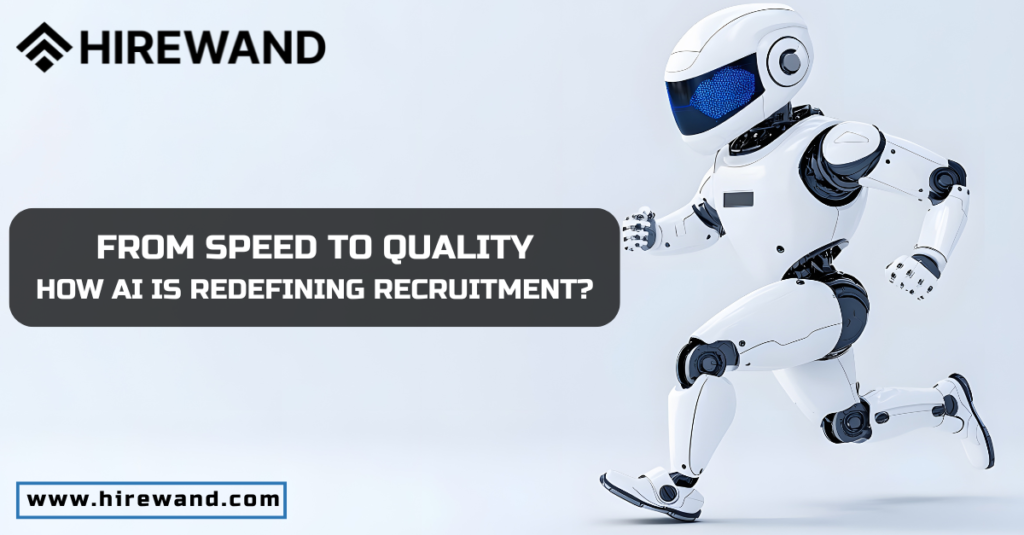
The Changing Face of Hiring
The hiring landscape is undergoing a major shift, with AI Redefining Recruitment. For years, recruiters have focused on how quickly roles can be filled, but today the priority is shifting. Organizations are embracing AI-driven tools to move beyond speed and concentrate on hiring that truly fits—ensuring long-term success, stronger retention, and smarter talent decisions.
But as we enter the age of AI-driven hiring, that obsession with speed is giving way to a deeper priority: quality. Today, organizations are realizing that filling a role fast isn’t the same as filling it right.
According to a 2025 report by the Economic Times, nearly 75% of Indian recruiters now allocate up to 70% of their hiring budgets to AI tools that improve match accuracy and retention. The race is no longer to hire faster—but to hire better.
Why Speed Alone No Longer Works
Traditional hiring processes often measure success through time-to-hire or cost-per-hire. But these metrics can be misleading. A quick hire who leaves in six months can end up being more costly than a slower, strategic one.
The modern Indian workforce—especially Gen Z professionals—values alignment, growth, and purpose. A recruiter focused purely on speed risks overlooking the subtle, human dimensions of fit: team culture, learning orientation, and value alignment.
Add to that India’s fast-changing skill landscape—where new technologies create new roles faster than universities can adapt—and it’s clear why quality hiring is the only sustainable recruitment strategy.
The AI Advantage: Beyond Resume Screening
AI in recruitment is no longer about keyword scanning or chatbots. It’s about intelligent decision-making.
Here’s how advanced systems like Hirewand’s AI stack are helping Indian organizations transform their hiring outcomes:
1. Predictive Matching
AI models now analyze historical hiring data—who succeeded, who didn’t, and why—to predict future fit. These systems look beyond skills to evaluate behavioral patterns, adaptability, and role longevity.
2. Bias-Aware Screening
Sophisticated algorithms can flag potential bias in job descriptions, scoring systems, or interviewer feedback, ensuring a more inclusive shortlist.
3. Conversational AI for Candidate Engagement
Recruiters lose up to 40% of qualified candidates to poor follow-up. Automated candidate engagement tools powered by generative AI keep communication active, personalized, and warm—boosting candidate experience without increasing workload.
4. Real-Time Hiring Insights
AI dashboards now provide dynamic insights—such as “which sourcing channels yield high-retention hires” or “which interviewers correlate with successful placements.” Recruiters can iterate hiring strategies on the fly.
A Shift in KPIs: Measuring What Really Matters
As the focus shifts from quantity to quality, recruitment teams are adopting new success metrics.
| Traditional Metrics | Emerging Quality Metrics |
|---|---|
| Time-to-Hire | Quality-of-Hire |
| Number of Hires | Retention After 12 Months |
| Cost-per-Hire | Candidate Experience Scores |
| Offer Acceptance Rate | Performance of New Hires |
Quality-of-hire—measured through performance, retention, and peer feedback—is becoming the north star metric for modern TA teams.
AI makes this measurable. By connecting post-hire performance data to pre-hire assessments, recruitment leaders can finally close the loop between who we hire and how they perform.
Real-World Impact: How Indian Companies Are Adapting
Tech Startups
Fast-growing startups in Bengaluru and Hyderabad are adopting AI to identify culture-fit candidates early, reducing attrition by as much as 30% in some cases.
Large Enterprises
Enterprises are using AI to analyze historical attrition data to predict which hires will stay longer—helping optimize not only recruitment but workforce planning.
SMBs and Regional Firms
Even small and mid-sized businesses are realizing that quality trumps quantity. With affordable AI-as-a-service platforms, they can now access predictive hiring capabilities once reserved for large corporations.
The Human Element: Where Recruiters Still Matter Most
AI can rank, predict, and automate—but it can’t replace human intuition, empathy, and storytelling.
A recruiter’s ability to see beyond the algorithm—to notice potential, passion, and purpose—remains irreplaceable. The new recruiter’s role is that of an AI-augmented talent strategist, not a gatekeeper.
They interpret AI insights, question anomalies, and build trust with candidates. In short, AI provides the data; humans deliver the decision.
How to Begin Your Shift from Speed to Quality
For teams ready to make this transformation, here’s a simple roadmap:
- Define what quality means for your organization. Is it retention? Innovation? Performance?
- Adopt the right tools. Start small—AI-based resume matching, candidate scoring, or engagement bots.
- Train your recruiters. Empower them to interpret AI results, not just consume them.
- Measure and iterate. Track long-term outcomes, not just hiring velocity.
- Keep it human. Automation amplifies good processes, not broken ones.
The Road Ahead
India’s recruitment landscape is at a defining crossroads. Those who continue chasing speed will find themselves stuck in endless hiring cycles. Those who embrace AI-driven quality will build stronger, more adaptable teams.
In the coming years, the most successful recruiters won’t be those who hire the fastest—they’ll be those who hire for impact.
At Hirewand, we believe that’s the future worth building: a world where AI empowers human judgment, not replaces it.
Visit www.hirewand.com to book a free demo with us.